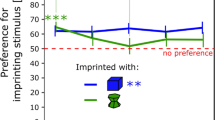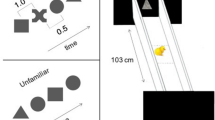Abstract
IN many different animals and in a variety of circumstances, the rates of protein and RNA synthesis in the central nervous system seem to be affected by environmental stimulation1–3 although this relationship is not well defined. One promising situation which may help to clarify the relations is found shortly after hatching in many precocial birds. At this stage environmental stimuli can exert a long term effect on social behaviour. The process by which a bird's preference for a particular object becomes restricted to that object is known as “imprinting”4,5. The situation is admittedly complicated in that any effects of experience on the nervous system are superimposed on maturational changes that proceed in the absence of such experience. Nevertheless, potential advantages of the imprinting situation are that the previous experience of the animal is very limited, the initial stages of the learning process are rapid and, in the absence of appropriate stimulation, the development of a preference can be delayed. Here we describe the effects of visual experience in the imprinting situation on the incorporation of tritiated lysine into protein of different regions of the chick's brain.
This is a preview of subscription content, access via your institution
Access options
Subscribe to this journal
Receive 51 print issues and online access
$199.00 per year
only $3.90 per issue
Buy this article
- Purchase on Springer Link
- Instant access to full article PDF
Prices may be subject to local taxes which are calculated during checkout
Similar content being viewed by others
References
Booth, D. A., Psychol. Bull., 68, 149 (1967).
Kandel, E. R., and Spencer, W. A., Physiol. Rev., 48, 65 (1968).
Rose, S. P. R., in Applied Neurochemistry, 356 (edit. by Davison, A., and Dobbing, J.) (Blackwell, Oxford, 1968).
Bateson, P. P. G., Biol. Rev., 41, 177 (1966).
Sluckin, W., Imprinting and Early Learning (Methuen, London, 1964).
Gottlieb, G., J. Comp. Physiol. Psychol., 54, 422 (1961).
Bateson, P. P. G., and Reese, E. P., Anim. Behav., 17 (in the press).
Rose, S. P. R., Nature, 215, 253 (1967).
Rose, S. P. R., in Macromolecules and the Function of the Neuron, 343 (edit. by Lodin, Z., and Rose, S. P. R.) (Excerpta Medica, Amsterdam, 1968).
Author information
Authors and Affiliations
Rights and permissions
About this article
Cite this article
BATESON, P., HORN, G. & ROSE, S. Effects of an Imprinting Procedure on Regional Incorporation of Tritiated Lysine into Protein of Chick Brain. Nature 223, 534–535 (1969). https://doi.org/10.1038/223534a0
Received:
Revised:
Issue Date:
DOI: https://doi.org/10.1038/223534a0
This article is cited by
-
Role of RNA and protein in memory storage: A review
Behavior Genetics (1974)
-
Effects of Imprinting on Uracil Incorporation into Brain RNA in the “Split-brain” Chick
Nature (1971)
-
Effects of an Imprinting Procedure on Regional Incorporation of Tritiated Uracil into Chick Brain RNA
Nature (1970)
-
Effects of an Imprinting Procedure on RNA Polymerase Activity in the Chick Brain
Nature (1970)
Comments
By submitting a comment you agree to abide by our Terms and Community Guidelines. If you find something abusive or that does not comply with our terms or guidelines please flag it as inappropriate.



